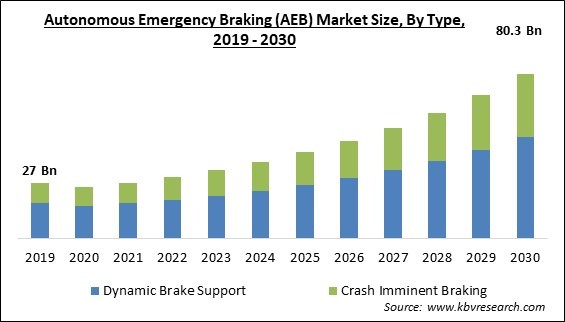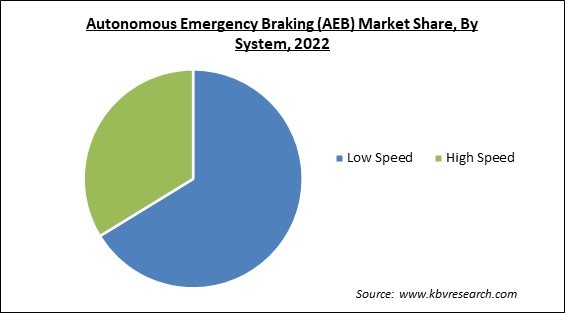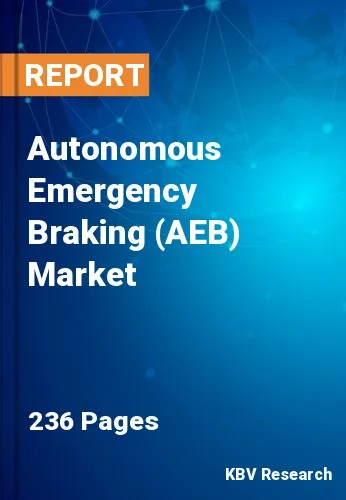The Global Autonomous Emergency Braking (AEB) Market size is expected to reach $80.3 billion by 2030, rising at a market growth of 13.4% CAGR during the forecast period.
Asia Pacific region increasingly include emergency braking systems in their car models. OEM market competitiveness fuels Asia Pacific’s demand for advanced braking systems. Consequently, the Asia Pacific generated $8.6 billion revenue in the market in 2022. OEMs in the They know the need for cutting-edge safety measures and aim to differentiate themselves from other manufacturers by providing emergency braking as a standard or optional feature. Some of the factors impacting the market are significant R&D investment in the development of AEB system, raising awareness of road safety, and High initial costs could prevent adoption.

The demand for increased road safety has led to an abrupt spike in this market. Automotive market participants have invested in significant R&D (Research and Development) to enhance AEB systems. The goal of R&D is to improve the performance and applicability of emergency braking systems while also expanding their capabilities and efficacy. By making R&D investments, market participants hope to raise the efficiency, dependability, and overall performance of advanced braking systems. These developments boost customer confidence, satisfy regulatory standards, and promote the market acceptance of advanced braking system technology. Due to growing traffic and congestion, the safety of people has taken on the highest priority, giving rise to various telematics solutions. A key element propelling market’s expansion is the improvement of advanced driver assistance systems (ADAS) features in automobiles. These programs raise public awareness of the importance of safety technology and encourage manufacturers and governments to fund and support the implementation of cutting-edge safety systems like AEB. As a result, market growth is projected in the coming years.
However, advanced sensor technology, complex algorithms, and interaction with other safety systems used by AEB systems can raise the cost of vehicle manufacturing. Some consumers, especially in price-sensitive regions, may be turned off by the more significant costs associated with improved braking systems, which could hinder market expansion and adoption. The retrofit market is constrained, and the general adoption of advanced braking systems is hampered by the retrofitting process, which might vary based on the make and model of the vehicle.
Based on type, the market is bifurcated into crash imminent braking and dynamic brake support. In 2022, the dynamic brake support segment registered the highest revenue share in the market. DBS systems can enhance a vehicle's overall braking performance by providing additional braking power or adjusting the brake force distribution among the wheels. Through performing this, users can shorten braking distances and increase vehicle stability in challenging driving situations. The need for increased safety and braking process management drives the demand for DBS systems.
On the basis of system, the market is categorized into low speed and high speed. The high-speed segment garnered a significant revenue share in the market in 2022. There is a rising focus on enhancing highway safety because high-speed accidents can have serious repercussions. High-speed braking systems are designed to recognize and react to crashes that might occur at faster speeds, such as rear-end collisions or lane departure accidents on highways. The need to lessen the seriousness and frequency of highway accidents has fueled the demand for high-speed braking systems.

By vehicle type, the market is segmented into passenger cars and commercial vehicles. In 2022, the passenger cars segment dominated the market with the maximum revenue share. Consumer awareness and safety concerns have increased substantially, driving demand for vehicles with cutting-edge safety features. The emergency braking systems have been commended for their aptitude to recognize potential collisions and automatically apply brakes, lowering the probability of accidents and reducing their severity. The rising demand for passenger cars with increased safety features has spurred the adoption of sophisticated braking systems.
| Report Attribute | Details |
|---|---|
| Market size value in 2022 | USD 29.9 Billion |
| Market size forecast in 2030 | USD 80.3 Billion |
| Base Year | 2022 |
| Historical Period | 2019 to 2021 |
| Forecast Period | 2023 to 2030 |
| Revenue Growth Rate | CAGR of 13.4% from 2023 to 2030 |
| Number of Pages | 236 |
| Number of Table | 320 |
| Report coverage | Market Trends, Revenue Estimation and Forecast, Segmentation Analysis, Regional and Country Breakdown, Companies Strategic Developments, Company Profiling |
| Segments covered | Type, System, Vehicle Type, Region |
| Country scope | US, Canada, Mexico, Germany, UK, France, Russia, Norway, Netherlands, China, Japan, India, South Korea, Singapore, Taiwan, Brazil, Argentina, UAE, Saudi Arabia, South Africa, Nigeria |
| Growth Drivers |
|
| Restraints |
|
Region-wise, the market is analysed across North America, Europe, Asia Pacific, and LAMEA. In 2022, the North America region witnessed the largest revenue share in the market. In North America, there is an increasing focus on improving road safety, mainly to lower the rate of accidents and severity. Critical safety elements such as advanced braking systems can lessen or avoid collisions. The growing awareness influences the demand for autonomous emergency braking systems and the need for traffic safety. Furthermore, North American consumers are becoming more aware of the advantages of emergency braking systems.
Free Valuable Insights: Global Autonomous Emergency Braking (AEB) Market size to reach USD 80.3 Billion by 2030
The market research report covers the analysis of key stakeholders of the market. Key companies profiled in the report include Robert Bosch GmbH, Continental AG, ZF Friedrichshafen AG, Hyundai Mobis Co., Ltd. (Hyundai Motor), Aisin Corporation (Toyota Motor Corporation), Hitachi, Ltd. (Hitachi Astemo, Ltd.), Valeo SA, HL Mando Corporation, Netradyne, Inc., and Aptiv PLC
By Type
By System
By Vehicle Type
By Geography
This Market size is expected to reach $80.3 billion by 2030.
Significant R&D investment in the development of AEB system are driving the Market in coming years, however, High initial costs could prevent adoption restraints the growth of the Market.
Robert Bosch GmbH, Continental AG, ZF Friedrichshafen AG, Hyundai Mobis Co., Ltd. (Hyundai Motor), Aisin Corporation (Toyota Motor Corporation), Hitachi, Ltd. (Hitachi Astemo, Ltd.), Valeo SA, HL Mando Corporation, Netradyne, Inc., and Aptiv PLC
The expected CAGR of this Market is 13.4% from 2023 to 2030.
The Low Speed segment is leading the Market by System in 2022; thereby, achieving a market value of $51.6 billion by 2030.
The North America region dominated the Market by Region in 2022, and would continue to be a dominant market till 2030; thereby, achieving a market value of $25.6 billion by 2030.
Our team of dedicated experts can provide you with attractive expansion opportunities for your business.

